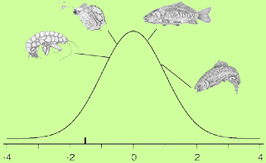| |
 |
 | '
Estimating the 5-percentile of the species sensitivity distributions
without any assumptions about the distribution.
Nelly van der Hoeven*
ECOSTAT, Vondellaan 23, 2332 AA, Leiden, The Netherlands
* Corresponding Author:
Nelly van der Hoeven,
ECOSTAT,
Vondellaan 23,
2332 AA Leiden,
The Netherlands
tel.: (+)31-(0)71-5315011; fax: (+)31-(0)842-116988;
email:
Summary
A non-parametric method is described to estimate the hazardeous concentration for p% of the species, the HCp, and the confidence limits for this value, the
HCp(α). For this method, all observed sensitivities are ordered from high to low sensitivity. The HC5 is the k-th observation were k is the largest integer below 0.05×(n+1). It is described how the
HCp(α) can be calculated. A table is presented for easy calculation of several conservative confidence limits for the HC5. For the HC5(0.05), a second table is presented which can be used to interpolate between the conservative estimate of the HC5(0.05) and the next higher observed concentration.
The non-parametric HC5 and HC5(0.05) estimation is illustrated with an example of sensitivity data on malathion. For this data set, the log-normal HC5 and HC5(0.05) estimations appear to be conservative compared with the non-parametric estimate. It is stressed that HC5 and HC5(0.05) estimates will often be much more affected by the non-randomness of the species set for which sensitivity data are available than by the choice of the statistical method.
keywords: beta distribution; hazardeous concentration
Ecotoxicology 10: 25-34, 2001
Statistical methods and models
ECOSTAT uses a broad range of statistical methods and models. Sometimes, the standard methods will not suffice. In that case, ECOSTAT can adapt and extent the existing methods to make the method better applicable to your data and research questions.
Some examples of ECOSTAT's experience
-
Ecotoxicological studies, where the test chemical is dosed with a solvent, are often performed using two controls, a blank control and a solvent control. For the statistical analysis of these studies, it is often recommended to combine the data from both controls if they do not differ significantly and otherwise only use the data from the solvent control for the significance test on the effects of the chemical treatment. Nelly van der Hoeven of ECOSTAT has demonstrated in a simulation study that this method is incorrect.
- In ecotoxicological research the so-called No Observed Effect Concentration (NOEC) is often reported, that is the highest test concentration without a significant difference between that concentration and some control observation. To judge whether not observing an effect can be considered as an indication of at most a small effect, it is essential to indicate how large the effect should have been to be marked as significant, that is the Minimum Significant Difference (MSD). For normal distributed data, methods to calculate the MSD were already available.
Nelly van der Hoeven of ECOSTAT had developed a method to calculate the MSE for non-parametric statistical tests.

- The environmental risk of a chemical has to be assessed using toxicological data for only a small set of species. Based on such a small data set the maximum acceptable environmental concentration has to be assessed. One of the methods to extrapolate such a limited data set to the risk for the complete environment is to estimate the concentration at which at least 95% of the species will not be affected at all. This concentration is called the HC5. To apply this method it is usually assumed that the sensitivuity of the different species is log-normal distributed. Nelly van der Hoeven van ECOSTAT has developed a method to estimate the HC5 without any assumption on the distribution of the sensitivity of the different species.
|
|
|